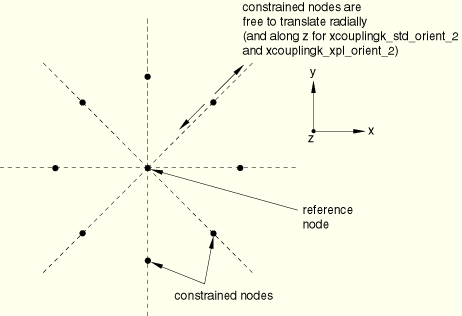Product: ABAQUS/Standard
Various types of kinematic coupling connections are tested by using the *KINEMATIC COUPLING option to selectively constrain degrees of freedom. Where tests are equivalent to existing *MPC tests, references to those verification tests are made. Refer to “*MPC,” Section 5.1.15, for details of these tests.
Problems xkcbeam.inp and xkcbem3.inp impose beam constraints using the *KINEMATIC COUPLING option and are the same as the equivalent MPC problem. Problem xkcrevo.inp tests the finite-rotation revolute behavior of the kinematic coupling when only two rotational degrees of freedom are constrained. Problem xkcuniv.inp tests the finite-rotation universal behavior of the kinematic coupling when only one rotational degree of freedom is constrained.
The geometry for problems xkccirc.inp and xkccirc2.inp is shown in Figure 5.1.12–1.
Figure 5.1.12–1 Geometry for xkccirc.inp and xkccirc2.inp.

In the case of xkccirc.inp the kinematic coupling constrains all but the radial degree of freedom at the constrained nodes. Linear springs to ground (SPRING1) are attached to all constrained nodes and act in the x-direction. The reference node is then rotated ![]() about z during a static step.
about z during a static step.
In the case of xkccirc2.inp the kinematic coupling constrains the circumferential degree of freedom only. Linear springs to ground (SPRING1) are attached to all constrained nodes and act in the x- and z-directions. The reference node is then rotated ![]() about x during a static step.
about x during a static step.
Problem xkcsort.inp consists of a model composed of an axial arrangement of 20 shell elements. These elements are tied together using combinations of kinematic coupling constraints as well as MPCs. The constraints are defined such that kinematic coupling reference nodes appear after constraint definitions that eliminate degrees of freedom on these nodes; thus, sorting is required. The structure is clamped on one end and a concentrated axial load is applied to the other end.
The tests with equivalent MPC verification problems result in identical behavior. Tests xkcrevo.inp and xkcuniv.inp result in behavior that is identical to that of the equivalent revolute and universal MPCs.
Tests xkccirc.inp and xkccirc2.inp result in motion of the constrained nodes, under action of the linear springs, as the reference node rotates. For test xkccirc.inp this motion remains on the local radius passing through the node at all increments. For test xkccirc2.inp this motion remains in the plane defined by the original configuration local radius and global z-direction as this plane rotates according to the motion prescribed at the reference node.
Test xkcsort.inp results in an internal sorting of MPC and kinematic coupling definitions so that a proper elimination order is achieved.
Equivalent to MPC type BEAM in a plane (xmpcbeam.inp).
Equivalent to MPC type BEAM in space (xmpcbem3.inp).
Test of revolute rotational constraint behavior.
Test of universal rotational constraint behavior.
Local orientations defined and release of a single translational degree of freedom.
Local orientations defined and release of two translational degrees of freedom.
User subroutine ORIENT used in xkccirc2.inp.
Test of internal sorting of kinematic coupling definitions.